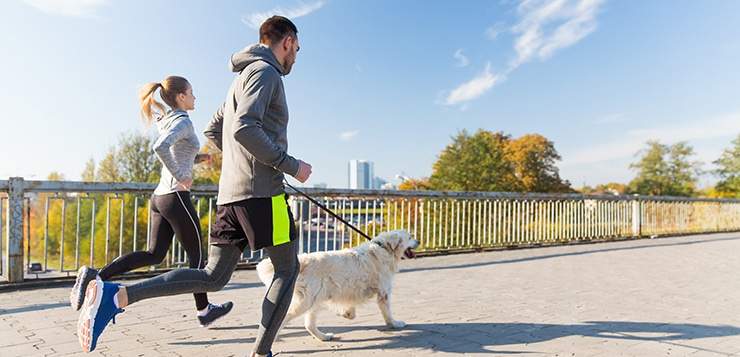“Nothing ever becomes real till it is experienced.”
—John Keats, poet
The revelation that mindfulness can happen with movement is often profound for people—especially those who have resisted meditation because they don’t like to sit still. If you’re committed to morning workout sessions and enjoy the boost that physical movement can bring, you can try turning your activity into a mindfulness meditation.
Runner Ashley Hicks described it to Krista Tippett in a July 2017 On Being podcast this way: “I don’t run with music, headphones, anything—I call myself a true minimalist runner. Literally, it’s just me and my running clothes . . . it’s just the idea of allowing myself to settle into the run, settle in and to feel the road beneath your feet, settle in and really acknowledge your surroundings. When I run, it’s this idea of really being present and acknowledging where I am and what I’m doing and the purpose.”
For devoted and aspiring exercisers, here is some good news. Research suggests that those who intentionally focus on the feeling of moving and deliberately take in their surroundings enjoy exercise more. After tracking how much people exercised, how mindful they were while doing it, and how satisfied they were with their workouts overall, scientists at Utrecht University in the Netherlands suggest “mindfulness may amplify satisfaction, because one is satisfied when positive experiences with physical activity become prominent.” What that means for your daily routine is that being mindful can support your exercising habits, and vice versa.
What exactly does mindful exercise involve? You’re paying attention to your body: your muscles, pace, breathing, resistance, and tension. How does it feel to get out of your comfort zone and twist and stretch beyond your usual seated or standing positions? How do you feel emotionally? Are you energized and determined, or are you feeling depleted, maybe needing a minute to refresh? Listen to your needs, and push or protect yourself accordingly. Be mindful of your thoughts too. Do you have a drill sergeant in your head? Are you comparing yourself to the person doing yoga next to you, or do you bring a curious, kind attention to how your workout is going?
When you meditate through exercise, you’re also taking time to notice what’s around—whether it’s the rhythms of the gym or the changing scenery of an outdoor jog. Although music can be a great motivator, and the built-in TV screen on the elliptical machine is nice entertainment, try unplugging for at least part of your workout to truly meditate.
Harmonizing your mind and body is powerful. You’re making strides—figuratively and literally—for your physical and mental health.
Any activity can work for mindful meditation, and you can find anchors for your attention in the motions: Maybe it’s the point when your right hand enters the water while you swim (my go-to), or the contact of your feet on the pavement as you run. Weight lifters might use the up-and-down repetition of a barbell. Or, you could stick with the one anchor that is always available to you: your breath, in and out. Notice as it quickens or slows, and return to it whenever you find your mind drifting to a thought about that text message you forgot to answer, or the milk you accidentally left on the countertop.
Harmonizing your mind and body is powerful. You’re making strides—figuratively and literally—for your physical and mental health. And, if the research holds, you’re enjoying it more. With that reward potential, a sweaty mindfulness session might be easier to put permanently on the calendar.
8 Ways to Meditate Through Your Exercise Routine
- Pause and consider your purpose. Remember why you want to meditate. Is it to train your mind to focus and sustain attention? To learn to navigate emotions? Consider your intention for exercise, too. Is it to live longer, lose weight, or have more energy for your kids? This twofold motivation can help get you up and out, and keep you going.
- Unplug. To meditate through exercise, don’t listen to your favorite playlist, talk on the phone, read a magazine, or watch TV. Be fully present where you are: in the woods, on the sidewalk, or on the treadmill.
- Tap into body sensations. Bring your attention to your physical experience. Are there any parts of your body that are working extra hard? Does your body feel different today than it did yesterday? When I swim, I focus on the water gliding over my body, the muscles in my arms, and the sensation of my torso rotating with each breath.
- Use your breath as a cue to challenge yourself more or ease up as necessary. As you learned with mindful breathing, your inhale or exhale can be an anchor of attention while exercising. If your mind wanders, noticing a new “For Sale” sign in the neighborhood while you run or recalling an email you forgot to return, just notice the thought and reconnect with your breath. Observe the tempo of your breath as you work harder and as you cool down.
- Play with different anchors of attention. Experiment with attentional focal points other than your breath: each full rotation of your bike pedals, the up and down of a lunge. You can switch anchors as you vary your exercise, but stay focused on the rhythm of your anchor, returning to it when your mind wanders.
- Note your surroundings. There are two aspects of directing attention—focused attention and open awareness—and you can practice both while exercising. To tap into the latter, check out what’s around you. How is the air? Temperature? What are you hearing?
- Renew your resolve — burning hamstrings and all. One of the attitudes of mindfulness is acceptance—not wishing the present moment to be different than it is. A brilliant time to practice this is when you’re meditating through exercise. Do you notice any resistance to the workout experience—perhaps wishing you were almost done, or that the pain in your right foot would go away? Commit to your workout time, remember your reasons for being there, and try to stay present from start to finish.
- Exercise kindness. Notice the quality of your thinking during workouts: Can you appreciate your current ability, speed, and endurance just as they are? If you work out in a group, can you let go of the “comparing mind” and instead thank yourself for showing up for this healthy activity, and then go at the pace that’s just right for you?
Excerpt adapted from The Mindful Day by Laurie J. Cameron, © 2018. Reprinted by arrangement with National Geographic Partners, LLC.








